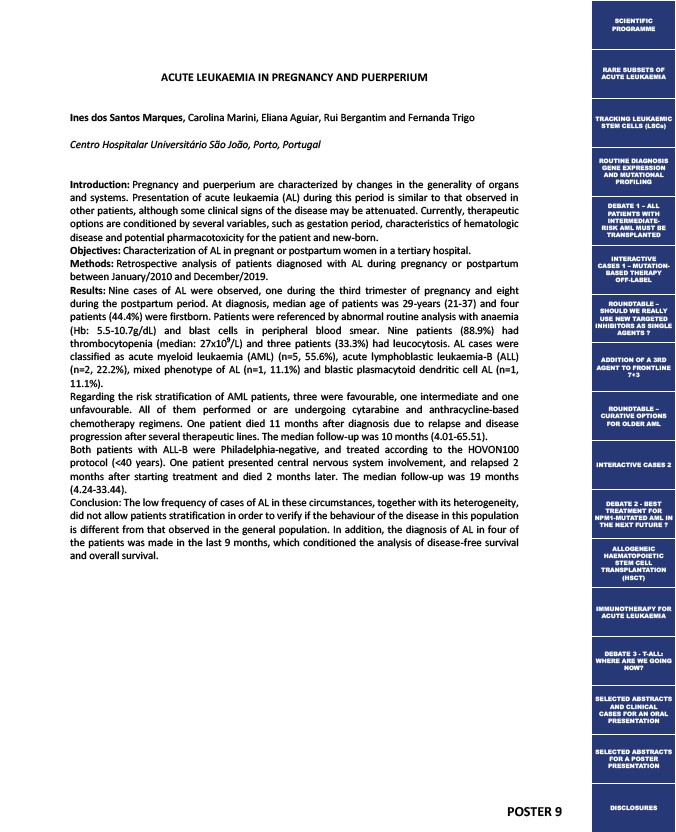
POSTER 9
ACUTE LEUKAEMIA IN PREGNANCY AND PUERPERIUM
Ines dos Santos Marques, Carolina Marini, Eliana Aguiar, Rui Bergantim and Fernanda Trigo
Centro Hospitalar Universitário São João, Porto, Portugal
Introduction: Pregnancy and puerperium are characterized by changes in the generality of organs
and systems. Presentation of acute leukaemia (AL) during this period is similar to that observed in
other patients, although some clinical signs of the disease may be attenuated. Currently, therapeutic
options are conditioned by several variables, such as gestation period, characteristics of hematologic
disease and potential pharmacotoxicity for the patient and new-born.
Objectives: Characterization of AL in pregnant or postpartum women in a tertiary hospital.
Methods: Retrospective analysis of patients diagnosed with AL during pregnancy or postpartum
between January/2010 and December/2019.
Results: Nine cases of AL were observed, one during the third trimester of pregnancy and eight
during the postpartum period. At diagnosis, median age of patients was 29-years (21-37) and four
patients (44.4%) were firstborn. Patients were referenced by abnormal routine analysis with anaemia
(Hb: 5.5-10.7g/dL) and blast cells in peripheral blood smear. Nine patients (88.9%) had
thrombocytopenia (median: 27x109/L) and three patients (33.3%) had leucocytosis. AL cases were
classified as acute myeloid leukaemia (AML) (n=5, 55.6%), acute lymphoblastic leukaemia-B (ALL)
(n=2, 22.2%), mixed phenotype of AL (n=1, 11.1%) and blastic plasmacytoid dendritic cell AL (n=1,
11.1%).
Regarding the risk stratification of AML patients, three were favourable, one intermediate and one
unfavourable. All of them performed or are undergoing cytarabine and anthracycline-based
chemotherapy regimens. One patient died 11 months after diagnosis due to relapse and disease
progression after several therapeutic lines. The median follow-up was 10 months (4.01-65.51).
Both patients with ALL-B were Philadelphia-negative, and treated according to the HOVON100
protocol (<40 years). One patient presented central nervous system involvement, and relapsed 2
months after starting treatment and died 2 months later. The median follow-up was 19 months
(4.24-33.44).
Conclusion: The low frequency of cases of AL in these circumstances, together with its heterogeneity,
did not allow patients stratification in order to verify if the behaviour of the disease in this population
is different from that observed in the general population. In addition, the diagnosis of AL in four of
the patients was made in the last 9 months, which conditioned the analysis of disease-free survival
and overall survival.
SCIENTIFIC
PROGRAMME
RARE SUBSETS OF
ACUTE LEUKAEMIA
TRACKING LEUKAEMIC
STEM CELLS (LSCs)
ROUTINE DIAGNOSIS
GENE EXPRESSION
AND MUTATIONAL
PROFILING
DEBATE 1 – ALL
PATIENTS WITH
INTERMEDIATE-RISK
AML MUST BE
TRANSPLANTED
INTERACTIVE
CASES 1 – MUTATION-BASED
THERAPY
OFF-LABEL
ROUNDTABLE –
SHOULD WE REALLY
USE NEW TARGETED
INHIBITORS AS SINGLE
AGENTS ?
ADDITION OF A 3RD
AGENT TO FRONTLINE
7+3
ROUNDTABLE –
CURATIVE OPTIONS
FOR OLDER AML
INTERACTIVE CASES 2
DEBATE 2 - BEST
TREATMENT FOR
NPM1-MUTATED AML IN
THE NEXT FUTURE ?
ALLOGENEIC
HAEMATOPOIETIC
STEM CELL
TRANSPLANTATION
(HSCT)
IMMUNOTHERAPY FOR
ACUTE LEUKAEMIA
DEBATE 3 - T-ALL:
WHERE ARE WE GOING
NOW?
SELECTED ABSTRACTS
AND CLINICAL
CASES FOR AN ORAL
PRESENTATION
SELECTED ABSTRACTS
FOR A POSTER
PRESENTATION
DISCLOSURES